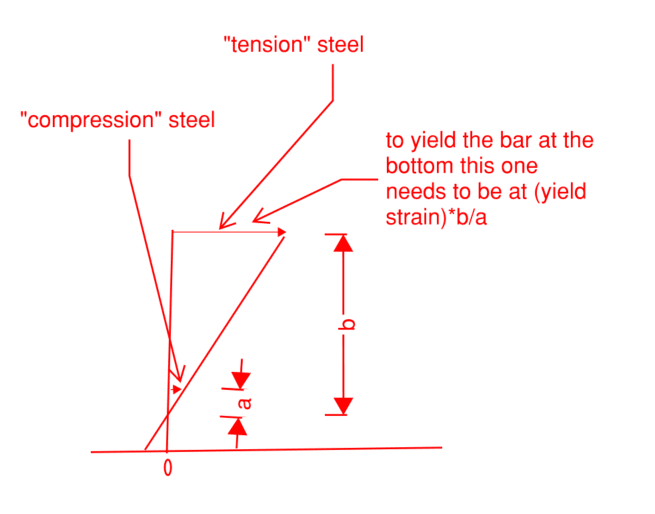I'm evaluating an existing condition, with a very lightly reinforced 2-way slab system.
We were trying to eek out capacity by considering compression steel at a support, but noticed that the neutral axis was very small. The "compression" steel was actually in tension at the ultimate limit state. In fact, in many sections we evaluated the bottom steel was even yielding in tension!
Yes, the bottom bar is fully anchored and developed at face of supports. However, I have some heartburn about developing yield (in tension) from the other side of the critical section, an issue that isn't present for the top bars (as sketched in the attached).
Consider the moment diagram of a fixed-fixed span. The negative moment decreases quadratically from peak negative moment at the face of support. The point at which the cracking moment is exceeded is qualitatively not that far away from the face of support. So there is (qualitatively) not much length to develop the tension force in the bar.
Thoughts? Is there something we're missing? (such as considering rebar slip?).
Cross section properties for those who like to check math:
180" width of 8" slab, 6ksi concrete
10#5 top bars (d=6.875")
15#5 bottom bars (d'=1.125")
We were trying to eek out capacity by considering compression steel at a support, but noticed that the neutral axis was very small. The "compression" steel was actually in tension at the ultimate limit state. In fact, in many sections we evaluated the bottom steel was even yielding in tension!
Yes, the bottom bar is fully anchored and developed at face of supports. However, I have some heartburn about developing yield (in tension) from the other side of the critical section, an issue that isn't present for the top bars (as sketched in the attached).
Consider the moment diagram of a fixed-fixed span. The negative moment decreases quadratically from peak negative moment at the face of support. The point at which the cracking moment is exceeded is qualitatively not that far away from the face of support. So there is (qualitatively) not much length to develop the tension force in the bar.
Thoughts? Is there something we're missing? (such as considering rebar slip?).
Cross section properties for those who like to check math:
180" width of 8" slab, 6ksi concrete
10#5 top bars (d=6.875")
15#5 bottom bars (d'=1.125")


